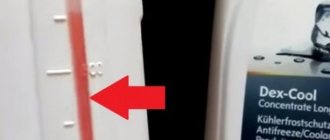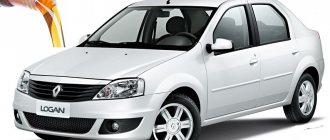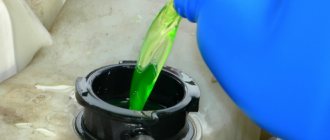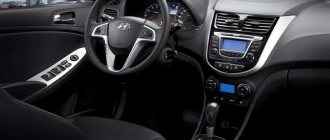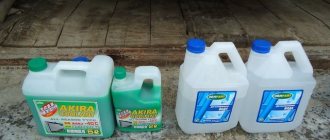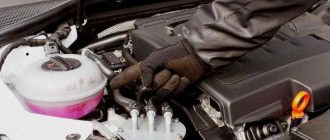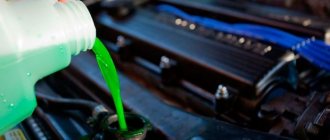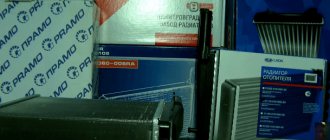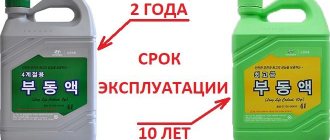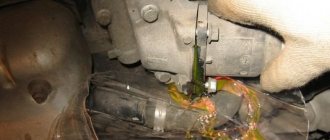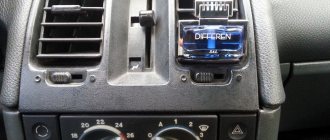07/11/2021 14,980 Cooling system
Author: Victor
The refrigerant in Hyundai Solaris, like any technological fluid, ages and loses its original characteristics. But before you begin the replacement, you should choose what antifreeze to pour into Solaris and familiarize yourself with the intricacies of the work.
[Hide]
What kind of antifreeze was added from the factory?
When initially filling the Hyundai Solaris cooling system, several types of refrigerant are used. Initially, the system was created using original Hyundai fluid labeled Long Life Coolant. This antifreeze fully complies with internal specification MS-591-08. But on Russian-assembled cars, in order to reduce the cost of cars and increase the percentage of localization, they began to use liquid branded CoolStream A-110 or Crown LLC A-110. These antifreezes have a rich dark green color and are supplied for replacement under the article number R9000-AC001H.
How to check the quality of new antifreeze?
Unfortunately, the situation on the market today is such that when buying even a well-known brand, it is advisable to check the quality of the purchase. Fortunately, this is very easy to do - just heat the liquid to a boil and see at what temperature it boils. It has been noticed that all the raw materials boil very early, but the high-quality ones do not boil before 107 degrees C at atmospheric pressure.
The temperature can be measured using, for example, a multimeter or an infrared thermometer
An infrared thermometer can give an error in the range from 3 to 7 degrees. This needs to be kept in mind.
Only 95, sometimes even below 90
If you do not check the liquid by temperature, check it visually by color. Counterfeit goods, as a rule, always very quickly lose their original color and become colorless or brown.
Reason to think about replacing
If you are unlucky with antifreeze or you have already bought a car with such liquid, the system needs to be flushed. How to do this is written below.
Replacement frequency
The manufacturer set the service life for the first fill of antifreeze to 10 years or 210 thousand kilometers. But given the difficult operating conditions of the vehicle over a wide range of ambient temperatures, it is advisable to reduce the first shift interval to 3 years or 45 thousand km. Each owner himself chooses the moment when it is necessary to replace antifreeze on the Hyundai Solaris for the first time. In this case, subsequent replacements should be made much more often - once every two years or after 30 thousand km.
Signs and reasons for the need for urgent replacement
Despite the long service life of the fluid, sometimes it needs to be changed ahead of schedule. A sign of deterioration in the condition of the refrigerant is a change in color, cloudiness, and the appearance of sediment in the expansion tank. This may be due to the fact that counterfeits are common on the antifreeze and oil market. A counterfeit product usually quickly loses color or, on the contrary, becomes almost black. Such liquid must be urgently drained with repeated flushing of the cooling system.
When to change antifreeze in Solaris?
Factory recommendation: First replacement 210 thousand km or 120 months. Then every 30 thousand km or 24 months.
Our recommendation is slightly different: If you plan to drive after 200 thousand km and, if possible, avoid problems with the pump, then it is advisable to replace the fluid earlier. . Why? Let's figure it out.
- In the manual, the resource is considered in time and mileage. If there are no questions by time, then the mileage figure needs clarification. When the car is mainly driven on the highway, without being in city traffic jams, you can focus on mileage, but usually the opposite is true. In this case, the engine operating time - engine hours - increases significantly and by 200 thousand km the antifreeze already loses a significant part of its properties. It is necessary to take into account that in traffic jams the coolant temperature is higher than on the highway. The difference is almost 10 degrees. You can notice how often the radiator cooling fan comes on during hot weather. Sometimes it works almost non-stop. All this negatively affects the life of the liquid.
- As for the entry in the manual: Then every 30,000 km or 24 months. The entry is strange and only valid if the cheapest coolants are used. If you use high-quality products, such a recommendation will not be correct. The timing and periods of replacement can be significantly extended.
- Another point that is also important is the cleanliness of the radiators. This does not mean inside, but outside - the radiator honeycombs themselves. We have two radiators in front. First the air conditioner radiator, then the main one. If they are clogged, this also affects the operating temperature of the fluid, and therefore its service life.
The bottom of the radiator is clogged with dirt
- Check whether you have radiator protection and in what condition it is. Small plastic part under the bumper.
Without it, radiators clog much faster.
What kind of coolant should I fill?
When performing work at an authorized dealer, original CoolStream A-110 or Crown LLC A-110 fluids are poured into the machine. A good alternative would be the already mentioned Hyundai Long Life Coolant (article 07100-00200 and 07100-00400). In addition to them, you can use any concentrates or ready-made liquids that comply with the G12+, G12++ and G13 standards. Some owners mistakenly believe that the green color of Korean antifreeze corresponds to the more common Volkswagen class G11 and pour such refrigerants into the cooling system. Filling Solaris with G11 antifreeze or antifreeze is strictly prohibited. You should not buy very cheap liquids, as they may not be of high quality.
Crown LLC A-110
Which product is better to use?
Car manufacturers recommend using the following types of antifreeze:
- Hyundai Long Life Coolant is an original concentrated product and is used for equipment assembled in Korea. Available in 2 liter and 4 liter containers.
- Crown LLC A-110 / Coolstream A-110 is completely ready for use and does not require dilution. This antifreeze is bottled in domestically produced cooling systems and is found in 1 liter containers.
To distinguish it from analogues, green dyes are added to the composition.
Consequences of mixing liquids of different brands
Before adding the product to an open expansion tank, the car owner is advised to make sure what kind of antifreeze was used previously. When mixing different grades, destruction of sealing materials may occur, as well as corrosion on metal surfaces.
The documents for the automotive equipment of this model indicate the specific composition of the product. It contains ethylene glycol and distilled water, as well as special additives to increase the beneficial properties of the liquid.
Important! When replacing, manufacturers recommend not to focus on what color the antifreeze is; the main thing is to take into account the brand, and not the color shade.
You cannot pour antifreeze or antifreeze of the G11 standard into Solaris. You can use fluids belonging to the G12+, G12++ and G13 standards.
Antifreeze replacement frequency
Directly complete replacement is carried out after a certain time has elapsed, or as a result of passing the required mileage. If this operation is ignored, unwanted deposits may appear inside the system, as well as early boiling of antifreeze in the radiator or tank.
- The car manufacturer recommends the first replacement of the product after traveling 200 thousand km, and also if 10 years have passed since the car left the factory.
- Subsequent replacements are carried out every two years, or after 30 thousand kilometers.
How to drain?
When replacing Hyundai Solaris antifreeze, there is no need to use additional equipment or special devices. The manipulations can be carried out independently in a private garage.
First, purchase a liquid with a capacity of 4 liters. Next, you need to carry out the following manipulations:
- remove the plastic engine protection;
- start the car, heat the engine until the thermostat opens;
- Leave the cooling system filler cap closed. It is located on a special tee;
- reach to the tap at the bottom of the radiator and unscrew it 2 turns.
- in this case, you should substitute a container for the used product;
- It is better to remove the cap from the filler neck at the end of the drain;
- drain the antifreeze from the block and radiator;
- Using a syringe with a piece of hose at the tip, remove any remaining liquid from the expansion tank.
Important! Be careful when handling faucets and caps. Excessive force may damage the marked components!
How to fill?
You need to tighten the drain valve and fill the coolant through the neck of the cooling system using a funnel.
After filling the system, close the filler neck with the cap. Next, pour antifreeze into the expansion tank 3-5 cm “L”
Start the engine and warm up to operating temperature. After warming up, if necessary, add antifreeze to about.
All replacement is complete. Check the coolant level occasionally and top it up when hot.
This is interesting: What is the difference between g11 and g12 antifreeze
Level control and required volume
The maximum capacity of the Solaris engine cooling system is 5.3 liters.
To control the liquid level in the system, a translucent expansion tank is used. It is installed directly on the radiator of the cooling system on the right side. On the front surface of the tank there are two notches with the designations L (low - low) and F (full - full). The volume of liquid in normal condition should be near the upper mark. The system will fully cool the engine only at this level. When the amount of liquid drops below the middle, especially below the L mark, refrigerant is added. Only add antifreeze of the brand that is in the system. Topping up is carried out through a special sliding funnel pipe located in the neck of the tank.
The tank is circled in red; liquid level marks are visible on the wall.
Possible causes of coolant consumption
During vehicle operation, the fluid level may decrease slightly. This is due to the fact that the expansion tank of the Hyundai cooling system is not completely sealed and antifreeze can evaporate from it. Significant loss of refrigerant within a short time indicates possible damage to the pipes or radiator. In this case, it is necessary to check the system and repair the damaged areas.
In this case, you should check that there is no antifreeze in the engine lubrication system. This happens when the sealing gasket between the head and the cylinder block is destroyed. If there is liquid in the oil, its level in the crankcase will increase significantly and traces of the emulsion will be visible on the dipstick.
Tips for replacing coolant
When replacing the coolant, do not open the radiator cap while the engine is running or hot. This can cause burns due to the release of hot liquid or steam, and can also cause failure of the engine cooling system.
Wait until the engine has cooled before replacing. Unscrew the radiator cap with the utmost care by wrapping the cap in a thick cloth and slowly twisting it counterclockwise .
Inspect the technical condition of all cooling and heating pipes and their connections. If there are worn parts, replace them.
The antifreeze level in the coolant tank must be located between the marks F (full) and L (low), marked on the edge of the expansion tank of the engine cooling system.
If the level is insufficient, it is necessary to top up the coolant to about. This will protect the cooling system from corrosion and freezing.
If you frequently add antifreeze to the system, it is recommended to check the system at a Hyundai service station for leaks.
Accidentally pouring antifreeze into the windshield washer reservoir can cause poor visibility when sprayed onto the windshield and/or damage the paintwork.
Necessary tools and materials for replacing antifreeze
List of what is needed for work:
- new coolant;
- clean rags;
- pliers;
- container for draining old fluid of at least 7 liters.
How to change the coolant?
Replacing antifreeze does not require special skills and can be done by the owner with his own hands. The work will take from 30 minutes to an hour and depends on the condition of the machine and the experience of the owner.
Tools and Supplies
The Solaris cooling system is designed in such a way that virtually no tools are needed for replacement. You may only need wrenches to remove the shields under the engine.
In the process of changing the refrigerant on a car manufactured in 2011, 2012, 2013, 2015 and other years of production, you will need:
- new antifreeze in the required volume;
- distilled water, at least 5 liters;
- a wide container for draining old liquid (container volume is at least 5 liters);
- rubber bulb or medical syringe with extension;
- rags for wiping;
- gloves;
- small funnel;
- a set of sockets or wrenches.
How to drain?
The first step in replacing antifreeze is to remove the old fluid from the system.
On Solaris, to do this you need to perform the following steps:
- Place the car on a horizontal pit or lift and allow the engine to cool.
- Open the filler necks on the radiator and expansion tank. The neck is installed on a special tee of the motor and is connected to the radiator by a pipe. You need to open the neck carefully, as there have been cases of it breaking off from the main body.
- Wipe off any dirt from the neck caps. It is unacceptable for contamination to get on the safety valve in the radiator cap, as this can lead to rupture of the cooling system elements.
- Remove the additional engine protective screen (if the vehicle has one).
- Remove the standard mudguard protecting the left side of the engine compartment.
- Under the mudguard you will see the lower part of the radiator with a small drain valve. Place the container and turn off the tap a little (one and a half to two turns). When manipulating the tap, do not use much force, as it can break off or damage the sealing ring.
- Drain the radiator and block. Remains from the expansion tank should be pumped out with a bulb or a large medical syringe with an extension tube attached to the spout. Collected refrigerant must be recycled. It is prohibited to pour it into the sewer system.
When draining the liquid, its quantity is rarely more than 3.5 liters. The rest of the antifreeze remains inside the cylinder block and heater core.
Replacing the fluid on the Kia Rio III, a single-platform car with the Hyundai Solaris, is demonstrated by the author of the Hyundai Solaris / Kia Rio.
Flushing the system
Before adding fresh refrigerant, you can flush the system with distilled water, although this procedure is not mandatory. The purpose of flushing is to more completely flush out the remaining old fluid from the system. There are various detergents for radiators and cooling jackets, but their use on modern cars is advisable only after the system has been repaired.
To perform work on Solaris you must:
- Close the drain valve, first checking the condition of the rubber sealing gasket. The torn part needs to be replaced.
- Pour distilled water through the radiator neck. When filling, it is necessary to periodically compress the fluid supply pipes to the radiator, thereby removing air bubbles from the system.
- After filling the radiator, you need to close its cap. Then you should pour water into the expansion tank to level F and close the filler cap.
- Start the engine for 2-3 minutes; while it is running, you need to monitor the water level in the tank.
- Stop the engine and drain the distillate according to the procedure described above.
- Considering how much liquid remains not drained, the system is washed with water several more times.
How to fill?
After draining the old fluid or flushing water, you can begin adding fresh antifreeze.
To do this, follow these steps on your machine:
- Close the drain valve.
- Fill with fresh coolant using a procedure identical to filling the system with flushing water. Antifreeze is poured 3-4 cm above the L mark.
- Start the engine and warm it up completely, while the cooling system fan should operate at least two or three times. It is necessary to monitor the parameters of the temperature indicator on the instrument cluster and the amount of liquid in the tank. Sometimes, during the initial warm-up of the unit after adding fresh refrigerant, the temperature sensor begins to indicate overheating of the motor, but the fan on the radiator does not turn on. In this situation, it is necessary to activate the heater to the maximum temperature and check what kind of air is supplied to the cabin. The intake of hot air indicates a breakdown of the fan activation system, and cold air indicates that the system is being aired out. To remove air, turn off the engine, cool it and open the radiator cap. Then you need to start the unit and the air bubbles will leave the system within a few minutes.
- After the engine has warmed up, add antifreeze to the tank up to the F mark.
- Replacement is complete. After a few days you need to check the level again. If necessary, add refrigerant to mark F.
After replacing the fluid, it is necessary to periodically evaluate its external condition for some time.
Topping up antifreeze
There is nothing complicated about how to change the coolant on a Hyundai Solaris. The first step is to purchase the required amount of antifreeze. For Solaris it is 5.3 liters. In addition to the antifreeze itself, you will need to acquire containers for draining. The engine must cool completely before the replacement process.
Further work is carried out in the following order:
- It is necessary to get rid of too much pressure in the system. To do this, remove the tank cap and radiator cap.
- To the left of the engine and slightly behind it is a shield that serves to protect the power plant from dirt. It needs to be dismantled.
- Access to the drain valve opens, which should be carefully unscrewed, but not all the way, leaving 1-2 turns. This will significantly reduce the pressure intensity and the amount of liquid drained. Place a container of the required volume under the tap.
- At this stage of work, it may turn out that the sealing ring on the tap is deformed, cracked and requires replacement. It needs to be replaced. Assuming the presence of this risk, it is better to buy the necessary part according to the corresponding catalog article before changing the antifreeze.
- After, according to calculations and the volume of the filled vessels, almost all the antifreeze has leaked out, the remaining antifreeze must be removed using a syringe or a syringe bulb.
- The tap is screwed in and fixed. Next, coolant is poured into the tank until it reaches the level indicated by the letter “L”.
- After closing the tank with the cap, the car starts.
At this moment, the fan may unexpectedly work, which indicates that the automation has diagnosed the problem. The antifreeze level has dropped. The engine is turned off and the fluid is added to the required volume.
The resulting air lock in most cases goes away on its own after an hour or two of use.
Consequences of untimely replacement
Long-term use of antifreeze leads to the destruction of the components included in its composition. In this case, precipitation or foam may form on the surface of the refrigerant in the expansion tank. These deposits clog the fluid supply channels in the block and cylinder head and impair engine heat transfer. In addition, they enter into various chemical reactions with metal and rubber parts of the cooling system. This often leads to the destruction of elements, the appearance of leaks from the system and even greater clogging.
An example of a tee from a cooling system worn out by old fluid
Photo gallery
The photos below show some steps for replacing antifreeze on Solaris.
Removing the standard shield under the radiator
Opening the drain valve
Draining the radiator
Removing the radiator cap
Completely removed faucet with o-ring
Filling with fresh fluid
Which antifreeze to choose?
To make a high-quality replacement of antifreeze on Hyundai Solaris, pay attention to the choice of coolant. It is recommended to purchase products from authorized dealers; this principle also applies to related consumables - cleaning agents and distilled water.
Regardless of the brand of antifreeze you choose, its recommended class is G12+ (red), which is also used at the manufacturer. It is not recommended to change the category and brand, but if such a need arises, you should thoroughly flush the system to eliminate any remaining waste coolant.
Video “Replacing antifreeze on Hyundai Solaris”
Author Seryoga K replaces the fluid on his 2014 Solaris.
Do you have any questions? Specialists and readers of the AUTODVIG website will help you ask a question
Was this article helpful?
Thank you for your opinion!
The article was useful. Please share the information with your friends.
Yes (100.00%)
No
X
Please write what is wrong and leave recommendations on the article
Cancel reply
Rate this article: ( 13 votes, average: 4.77 out of 5)
Discuss the article:

